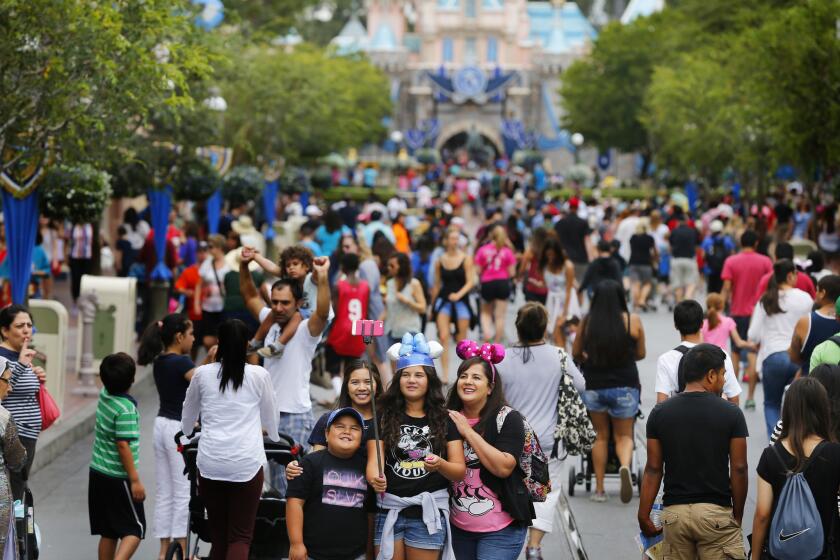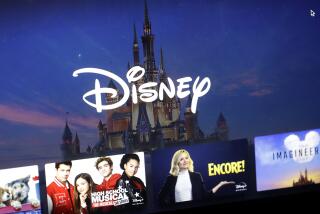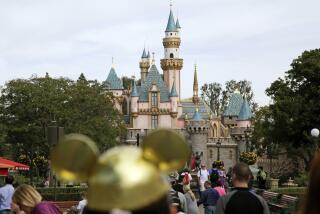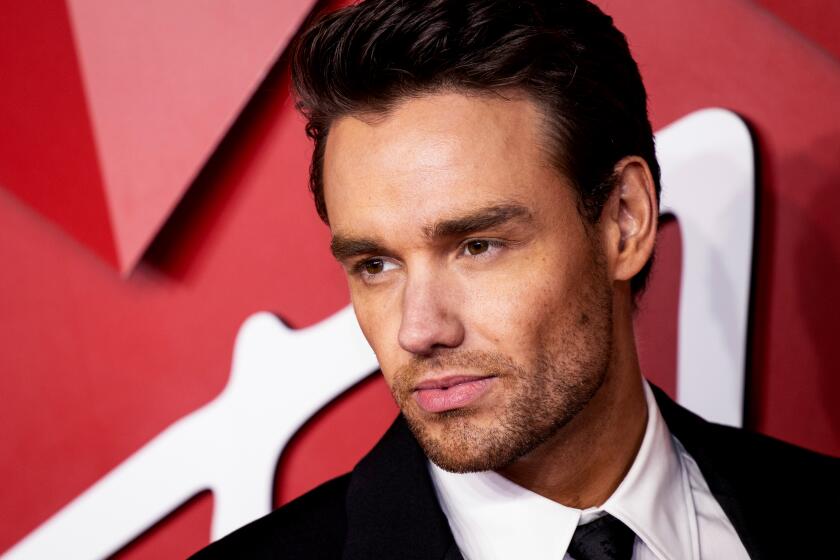Disneyland plans to reopen July 17, and Downtown Disney earlier
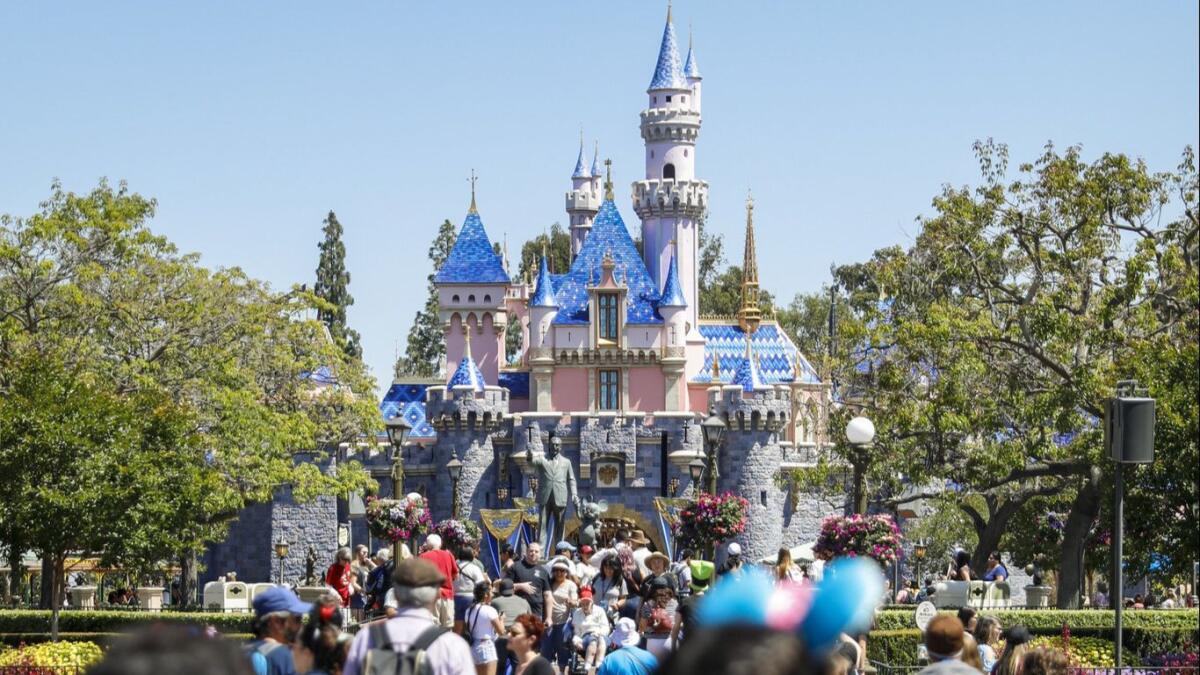
- Share via
The Disneyland Resort, closed since mid-March to help stem the spread of the coronavirus, is preparing to reopen just in time to celebrate the park’s 65th anniversary. The so-called happiest place on Earth is looking to begin a phased reopening in July.
Both Disneyland Park and Disney California Adventure will open July 17, pending local and state government approvals.
The Downtown Disney shopping district is slated to reopen July 9, with Disney’s Grand Californian Hotel & Spa and Disney’s Paradise Pier Hotel planning to open July 23. The Disneyland Hotel will open later, a company representative said.
The announcement, while not unexpected — Universal Studios in Florida began welcoming guests last week — comes as many parts of the country, including California, are experiencing a rise in coronavirus cases. Those growing case numbers are an expected consequence as stay-at-home orders implemented to stem the spread of COVID-19 are lifted and more parts of the economy reopen.
Capacity at Disneyland will be limited when the park reopens, and guests will be asked to make reservations in advance, Walt Disney Co. said in a statement. As part of the effort to strictly manage attendance levels, Disney put a “temporary pause” on new ticket sales and on annual pass purchases and renewals. A hotel reservation will also not guarantee access to the parks.
The Disneyland announcement was vague in detailing what health and safety measures guests would be asked to undertake. When outlining the reopening of the parks at Florida’s Walt Disney World, which is set to begin July 11, the company specified that guests will undergo temperature checks and wear masks.
It is expected that Disneyland will have similar requirements. When asked, however, a spokesperson referred to an official statement that read, “These policies are under continuous review and are subject to change as the Disneyland Resort monitors conditions and receives guidance from health and government authorities.”
Disney said its Anaheim parks will ask guests to practice physical distancing measures. Attendance will be heavily capped to help strangers give one another a wide berth. When Shanghai Disneyland reopened in May, the 80,0000-capacity park allowed in only 20,000 and pledged to gradually increase.
Disney doesn’t release attendance figures for its North American parks, but a daily crowd of about 65,000 was recently described as “normal” by one of Disneyland’s top creatives. Disney said experiences that encourage large crowds to gather, such as parades and firework shows, will be temporarily halted, as will character meet-and-greets.
How long will it be until Disneyland and other parks reopen? What will they look like? Here’s what we know so far.
Health experts said attending a theme park during a pandemic is, of course, a risk, especially with the added unpredictability of children’s movements. Being outdoors and maintaining physical distancing will help reduce the odds of catching the coronavirus, and experts agreed that another element is key: face masks.
“Hopefully everybody will wear a mask…. That massively cuts down the likelihood of transmission,” said Paula Cannon, a virology professor at the USC Keck School of Medicine. “I’d probably feel fairly comfortable walking around Disneyland wearing a mask and keeping in the least busy parts of the park and just paying attention. Would you get me to go inside Space Mountain sitting in a little compartment with someone sitting next to me? Hell no.”
It is believed that Disneyland will keep groups separate from one another on attractions, although specifics such as whether guests will be a full six feet apart have not yet been detailed. At Shanghai Disneyland, staffers have directed guests to stand in spaced-apart yellow squares for outdoor experiences and have kept ride vehicles at least half empty. In theater venues, rows have been blocked off.
Going on a ride doesn’t necessarily present a greater risk of COVID-19 exposure, health experts said, but it’s a complicated equation involving how riders are moving; how many viral droplets a rider is releasing via shouting, screaming or talking; where other riders are sitting; and whether anyone’s mask flies off.
“Let’s say you’re on a ride that’s outside and you’re moving incredibly fast. That keeps it difficult to keep masks on,” said Brandon Brown, an associate professor at UC Riverside’s Center for Healthy Communities. “If I’m coughing or sneezing, the person behind me may be more exposed to my breath or sneeze just because we’re moving.”
Disney said details on its reservation system would be forthcoming. Disneyland may draw on its recent experience with such systems. Last year, the park required guests to reserve slots in advance to visit the newly opened land Star Wars: Galaxy’s Edge in its opening weeks. Similarly, the company’s Shanghai Disneyland has been on a reservation-only system since reopening.
Burbank-based Disney, devastated by the COVID-19 pandemic, has been looking to get its operations up and running as soon as possible. Most media giants have been battered by the closures, but Disney was hit particularly hard because of its reliance on in-person experiences such as parks, movie theaters, cruise ships, retail stores and sports-hungry TV network ESPN.
As it began buttoning up businesses, the company sent home 2,200 college students and recent graduates enrolled in its internship programs in Anaheim and Florida. It also brought its four massive cruise ships back to port.
In April, the company took the extraordinary step of furloughing more than 100,000 staffers, many of whom were theme park and hotel workers. ESPN ratings swooned without live sports as a draw. Top executives including Chairman Bob Iger and recently installed Chief Executive Bob Chapek took large pay cuts.
Last month, the company reported that during the January-through-March quarter, earnings plunged 63% compared with the same period last year to 60 cents a share — far worse than Wall Street anticipated. Net income tumbled 91% to $475 million.
Disney has warned that this quarter, which ends June 30, it could miss out on as much as $1.4 billion in operating income because of the vacant theme parks and hotels, halted TV and film production and the lack of live sports on ESPN. Of that, $1 billion would be felt in its parks and experiences division.
The company’s stock price has plummeted from the record highs it reached after the successful November launch of the Disney+ streaming service.
Though reopening Disneyland comes with risks — on Wednesday, California reported more than 2,600 new coronavirus cases, bringing the total to more than 139,000 — USC’s Cannon is optimistic that if anyone can change the culture around mask-wearing and coronavirus safety, it’s Disney.
“Maybe they give everyone a Mickey Mouse face mask; maybe these become the new collector’s items instead of pins; maybe they create some excitement around that, so everyone wears their masks and keeps it on,” Cannon said.
The coronavirus era, if played right, could be a branding opportunity.
“Going to Disneyland is a shared experience,” she added. “So the slogan can be ‘the happiest and healthiest place.’”
More to Read
The biggest entertainment stories
Get our big stories about Hollywood, film, television, music, arts, culture and more right in your inbox as soon as they publish.
You may occasionally receive promotional content from the Los Angeles Times.
